
|
Historical Context
After the death of William in 1120, the only legitimate son of Henry I of England, the king named his daughter, Matilda, as his successor. Some of the English nobility did not favor the idea of having a queen as the sovereign of England, but the strength of Henry I demanded their allegiance to the throne. Matilda was the widow of the Emperor Henry V of Germany. Against her wishes, Henry I then forced the Empress Matilda to marry to Geoffrey of Anjou in 1127, and this marriage of politics was a strained relationship at best. When Henry I died on December 1, 1135, Matilda was in Anjou with her husband. Her cousin Stephen of Blois, hurried to England from Boulogne, got the support of many of the noblemen, and was crowned as king of England on December 22, 1135. Some of the nobility saw Stephen’s claim to the throne as illegitimate, and minor uprisings occurred.
In 1138 civil war and anarchy broke out in England, when Matilda, with support from her half-brother Robert of Gloucester, claimed her right to the throne. Robert’s initial military actions may have been in his own interest to claim more territory during this unsettled period, but he soon pledged his allegiance to Matilda and her cause. Matilda landed in Arundel, England on September 30, 1139, and stayed there until Stephen’s siege on October 15, when she was escorted by Stephen’s guard to Gloucester. Matilda then traveled to Bristol to set up her command.
The first five years of Stephen’s reign were filled with many castle sieges and three major battles. In 1138, at the Battle of the Standard, Stephen’s barons defeated the incursion by David I of Scotland, uncle to Matilda, and an uneasy truce was formed with the Scottish king. On February 2, 1141, Stephen was captured at the Battle of Lincoln, and then imprisoned at Bristol. The Empress Matilda, however, failed to garner public support for her coronation, and the civil war continued.
During the Battle of Winchester, September 14, 1141, Robert of Gloucester was captured by troops loyal to Stephen, and Robert and the king were both released in November 1141 as part of the Treaty of Winchester. Matilda’s failure to consolidate her power during Stephen’s imprisonment was the practical end of her dream to rule England, and the struggle then turned to gaining the kingdom for her eldest son, Henry of Anjou. The next twelve years were filled with unrest and military engagements, and the civil war finally ended in 1153, with Stephen acknowledging Henry as his successor.
Coinage
Silver pennies were the only coin of the time, and often were cut in half or quarters to create smaller denominations. During this tumultuous period in English history, many irregular coins were struck. Some of the barons were given, or assumed, the right to strike coins in their own names. Typical pennies had a royal bust on the obverse surrounded by a legend with the name, or name and title, of the sovereign. Some baronial and local coinage replaced the bust with a knight standing or on horseback. The reverse of the coin usually had some form of a decorative cross design, and a legend containing the name of the moneyer and the mint where the coin was struck.
However, the moneyer’s name and mint were not always present. Some moneyers took advantage of the unsettled conditions, struck coins of lower weight than required by law, and replaced the reverse legend with ornamental symbols, meaningless letters, and/or blundered strokes of partial letters so that the underweight coins could not be traced. Other moneyers struck coins with blundered legends when they did not want to show loyalty to either cause for fear of choosing incorrectly. In some instances, moneyers recalled as much of their own coinage as possible, and hammered out their name on each coin.
In addition, a few moneyers who did not have the ability or time to create or acquire new dies for their coins, defaced the bust of Stephen on existing dies to show their lack of support for the king. Some modern numismatists argue that coins with defaced dies were struck as a result of the Papal Interdict of 1148, but as Boon points out (Coins of the Anarchy 1135-54, 1988), defaced coins struck at Nottingham would have had to been struck before the great fire there in 1140.
Coins of this period are often poorly struck and under-weight. Quite often, the under-weight coins are very fragile, and broken coins are still collectible items.
Regular Issues of Stephen
The first regular issue of Stephen has a cross moline on the reverse, and is called the Watford type because of the large hoard of over 600 coins of this type found in Watford, Herts in 1818. The moneyer of the coin shown here is Osbern, and the mint is most likely Ipswich, but could be Oxford if the "G" is an "O."

|
The second regular issue is the Voided Cross type which has mullets in the four reverse quadrants. This coin may have been struck beginning in 1145, but I believe that it was struck earlier, perhaps shortly after the total solar eclipse that crossed England on March 20, 1140. The coin shown here (Seaby #1280) was struck in Thetford by Baldewin.
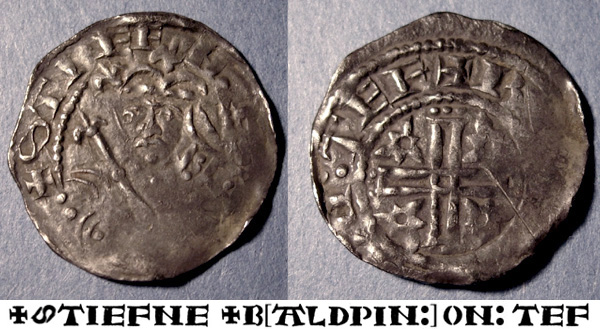
|
The third regular issue is the Cross Fleury type which has trefoils in the four reverse quadrants. This coin may have been struck beginning in 1150, but if the trefoils represent a comet, then this type may have been struck shortly after Halley's comet of 1145 that was seen in England. The coin shown here was struck in Norwich by Alfric.
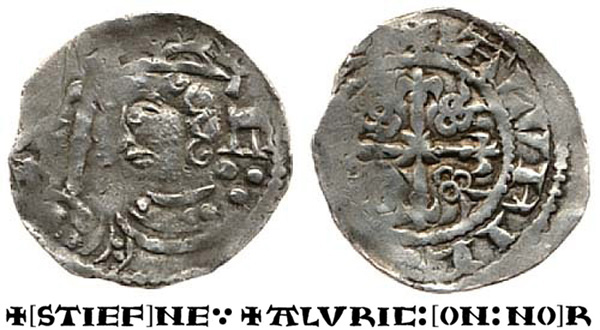
|
In 1154, Stephen’s last coinage was the Awbridge type, named after the Awbridge hoard found in 1902. This type continued to be struck during the first four years of the reign of Henry II. The coin shown here (Seaby #1282) has an interesting provenance.
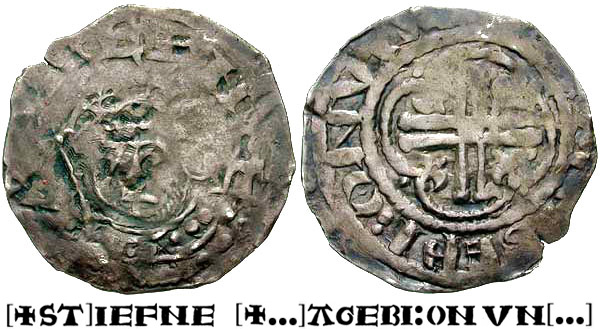
|
ex. Spink NC, February, 1948, #1515 ex. Lord Grantley collection, Part IV, Glendining's, 20 April 1944, #1300 ex. H. M. Reynolds sale, Sothebey's, 5 June 1919, #62 (sold for 8 Pounds Sterling) |
The traditional reading of this coin is ...ACEBI ON VN, but the more likely reading is AGEBI, AGERI, or ASEBI. VN is taken to be the beginning of an abbreviation for Huntingdon. This is a somewhat strange and truncated abbreviation. The real reading could be VIN or VVN, for Winchester, but this is debatable. There is no close match for any mint to any of the potential readings of the moneyer's name, making this a quite enigmatic and rare issue.
Irregular Varieties of Stephen's First Type
A very rare ecclesiastical Watford variety was struck by Gladewine in Lincoln. Three annulets on the crown are added to the obverse die, and annulets are found at the ends of the reverse cross moline. North (English Hammered Coinage, Vol. 1, 1994) attributes as ecclesiastical dies, minor varieties of the Watford type that have annulets in the crown or on the shoulder of the bust, or pellets on the reverse cross.
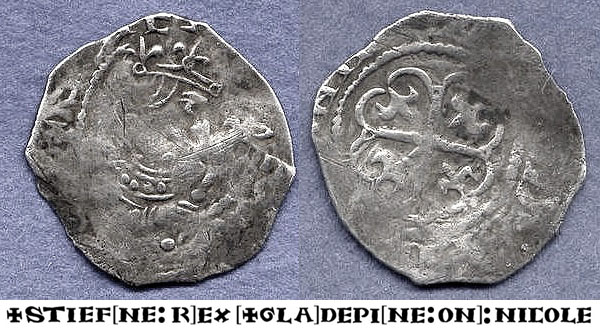
|
This Watford type cut half penny was struck by Elfric in Norwich using locally produced dies. Only a few examples are known.
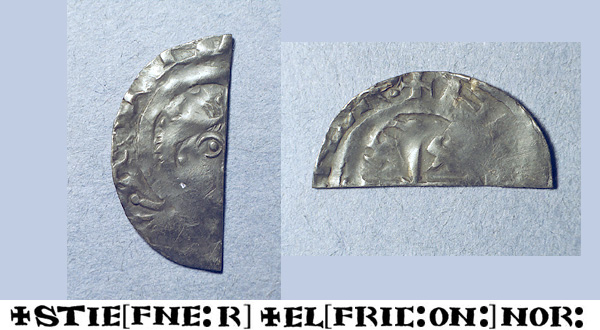
|
An extremely rare Watford variety has an annulet on the king's shoulder, and the lis in the reverse quadrants are replaced with annulets enclosing pellets. The cut half penny shown below, one of four known coins of this type, was struck by Wulnod in Northampton.

|
The coin shown above is the from the same dies as another cut half penny listed in the Fitzwilliam Museum Early Medieval Corpus (1996.0300). By combining the two coins, with 50% transparency from each coin in the overlap areas, an almost complete coin can be visualized.
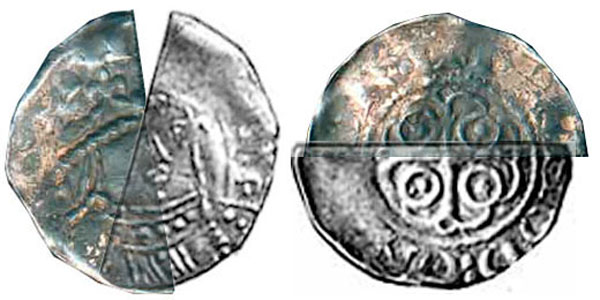
|
Queen Matilda
During Stephen's captivity between February and November, 1141, his wife, Queen Matilda, raised money and arms to fight for his release. In East Anglia, pennies of Stephen's first type were struck with roundels on the reverse cross, possibly representing the badge of the House of Boulogne. Matilda was the only child of the Earl of Boulogne.
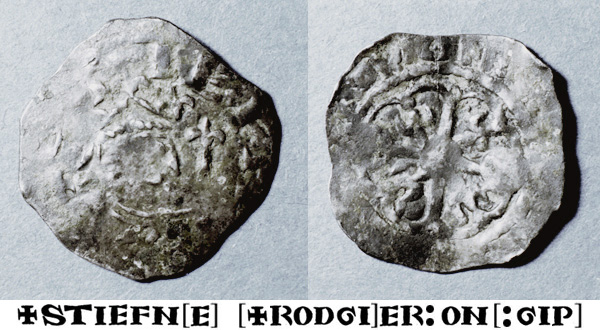
|
|
mint: Ipswich Fitzwilliam Museum Early Medieval Corpus (EMC) #2002.0150 Found on West Fen Road, Ely, Cambridgeshire, England Extremely Rare |
Defaced Die Varieties of Stephen's First Type
Watford type coins of Stephen were sometimes struck with defaced dies, most likely defaced by moneyers loyal to the king when the mint was in danger of being captured by Angevins, or if the mint had been captured. There are two known examples struck at Chichester that have a bar across the face of the king's bust, and a pellet on the king's shoulder. Chichester is located only eight miles from Arundel, where Matilda landed in England on September 30, 1139, and stayed until October 15th, when she traveled to Gloucester, and then to Bristol.
Coins of Bristol with defaced dies were most likely struck during the winter of 1139-1140, before Matilda struck coins from local dies bearing her name. The Chichester coins may have been struck during the same period, or perhaps when Stephen was held prisoner between February and November, 1141.
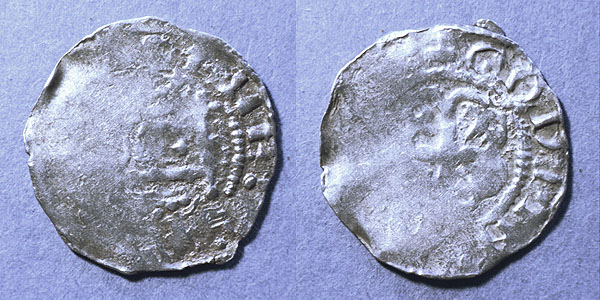
|
This coin was sold by the author in the CNG TRITON IX auction |
Local Die Varieties
York
One of the most interesting pennies from the York group portrays Stephen and Queen Matilda standing, facing each other, with a sceptre between. The reverse has a cross fleury over a cross pommee, annulets in angles, and ornaments in place of a legend. The example of this very rare coin shown here has a long provenance:
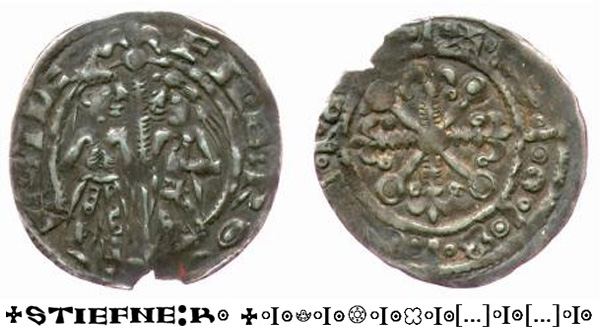
|
Another very rare Stephen type from York is similar to the Watford type, but the sceptre is replaced by a flag and a mullet. The mullet is often referred to on this coin as a star, but there are only 18 known examples of this coin, and some are clear enough to show the star as a mullet. Presumably, the others are worn to the point where the central hole of the mullet has been worn smooth.
The Flag type coin was originally thought to represent the standard carried into the battle at Northallerton in 1138, suggesting a date for the coin as early as then, but subsequent research has correlated the flag on the coin to Stephen’s second Great Seal which was adopted in June, 1139. I propose that the coin was stuck after the 1140 eclipse, as the second Great Seal does not have a mullet, and this coin was a local transitional piece between the Watford type and the Voided Cross type. The second flag penny shown has the letters EV at the end of the reverse legend, suggesting the York mint as a possible location where these coins were struck.
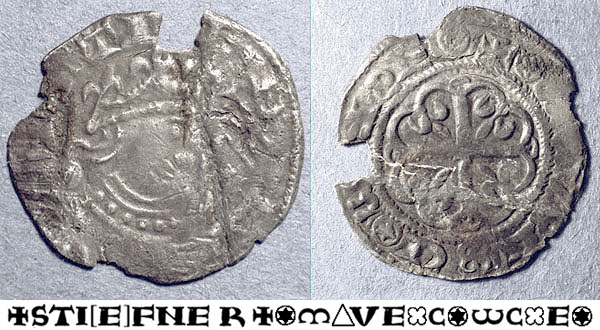
|
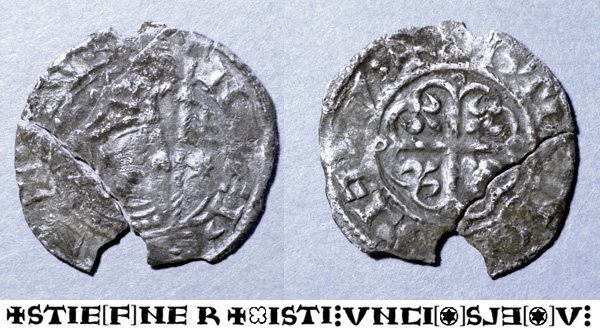
|
An extremely rare variety of "York group" pennies with ornamental reverse legends has a sceptre with a pelleted lozenge in lieu of a fleur at the top. This type may reflect French influence in the design, as this type of sceptre is found on royal French seals of the same period, and the "STIEN" spelling of Stephen in the obverse legend may have been derived from Estien.

|
A new and unique York type has been discovered. The only example is a cut half penny similar to the lozenge type, but the bust is bearded, and the reverse is unique to the series. The composite images shows what an entire coin might look like.
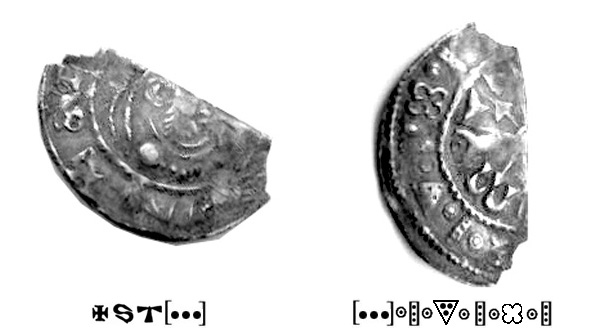
|
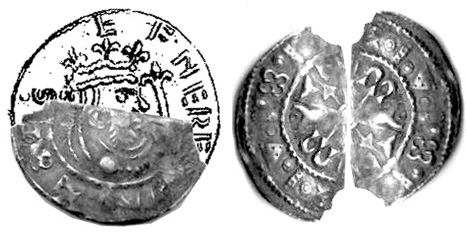
|
Midlands
One of the extremely rare midland variants of Stephen’s coins was struck at both Lincoln and Nottingham. The example shown here (Seaby #1301) was cut in half for use as a halfpenny, and it is impossible to determine the mint. There are only four known examples of the entire coin.

|
An extremely rare type (Mack 186-187) has an obverse similar to the Watford type, but with a rosette of pellets at the end of the legend. The reverse has a quadrilateral fleury and a large cross fleury superimposed on it. Four examples are known. Two are shown in Mack's article in BNJ 1966, the third is shown on the Fitzwilliam Museum's on-line Early Medieval Corpus (#1994.0288), and the fourth is the cut half shown below. None of the examples have clear enough legends to ascertain the mint location. Mack suggested southwestern England, and Seaby suggested the East Midlands.

|
Another extremely rare type (Mack 181-183) has an obverse similar to the Watford type, but with a rosette of pellets in front of the bust. The reverse has a cross with mullets in the quadrants.
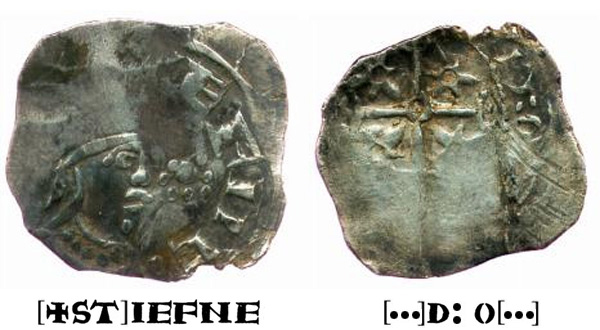
|
Baronial Issues
William of Gloucester succeeded his father, Robert, in 1147, and struck coins in his own name. The extremely rare coin (Seaby #1332) of uncertain mint is shown here.
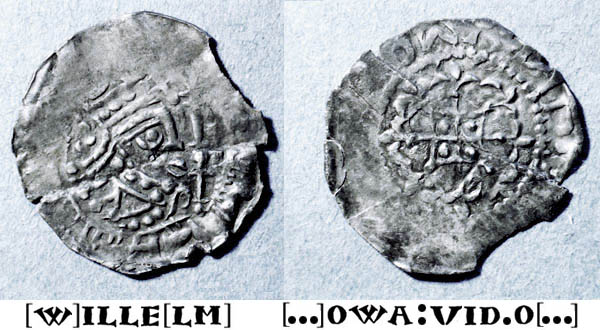
|
The following irregular coin is most likely a baronial issue, with a crude bust left and cross on the obverse, and a cross moline reverse. A partial legend suggests that the coin may have been struck at Ilchester. As with many other baronial issues, the period between 1139 and 1141 was of the greatest turmoil, and local coinage was struck as barons supported whichever side of the royalist-Angevin war they thought was winning.
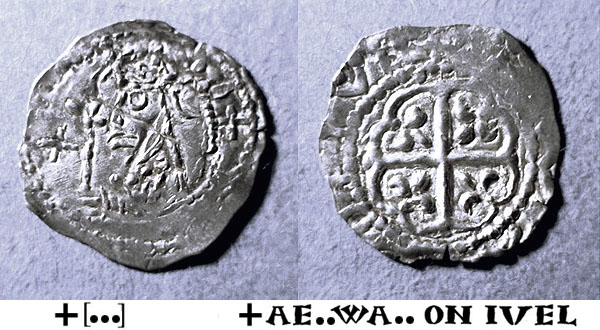
|
Blundered legends on irregular coins of the Anarchy were usually a sign of a moneyer who did not want to show loyalty to either cause for fear of choosing incorrectly, and/or a moneyer who debased his coinage during the anarchy, and did not want the sub-standard coins to be traceable.
The coin below was most likely struck by a bishop from northern England, or perhaps Scotland. Of particular interest is the modification of the sceptre with an annulet enclosing a pellet that replaces the royal fleur-de-lis. In addition, the lis on the crown are replaced by pellets. The annulet and pellets suggest a bishopric origin. One other coin of this type is known, and it was found in northern England.
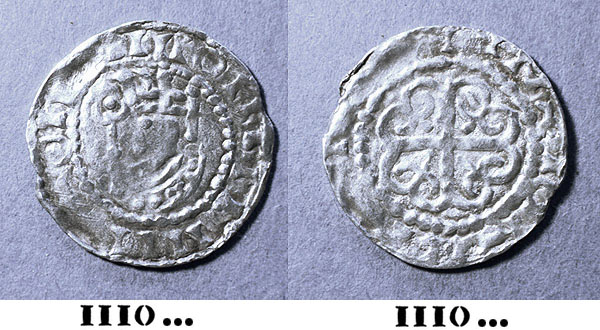
|
ex. "Beauvais" parcel of 20 coins, Extremely rare - one of two known |
The next coin is an unusual cut half penny with a trefoil of annulets in each quadrant of the reverse cross. North lists this coin as a variation of the cross and piles type of Stephen (N. 880, Mack #206, Lockett #1138) with an unintelligible obverse legend and a reverse legend of + S […]NE O[…]ER. North suggests York as a possible mint. The cut half penny, which weighs 0.51g, fills in most of the reverse letters of the moneyer’s name: SIM[V]N, although the die of the example shown here is slightly different from that shown as Mack #206. The cut half penny has +TO (Thomas?) at the beginning of the obverse legend, and therefore, the coin does not read any form of Stephen’s name, suggesting that it is a baronial piece and not a variety of Stephen’s coinage. Simun is a known moneyer of Stephen pennies struck in Leicester, but the ‘ER’ ending of the mint name on the Mack example does not match any of the known abbreviations for that mint. Simun is also known for striking irregular coinage (BMC type v). Until the complete obverse and reverse legends are known for this coin, its full attribution will remain a mystery.
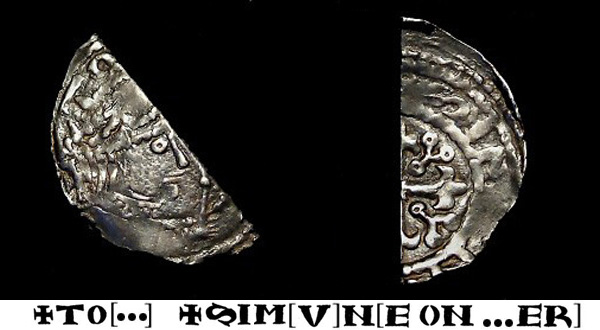
|
Scottish and Northern Border Issues
In 1136, David I of Scotland moved south into England, and captured Carlisle, thereby getting access to the newly created English mint and locally mined silver. After some period of time, a mint was created at Edinburgh, where this coin was struck (or perhaps at Carlisle for Edinburgh) by the moneyer Derlig, previously unknown as a Scottish moneyer.
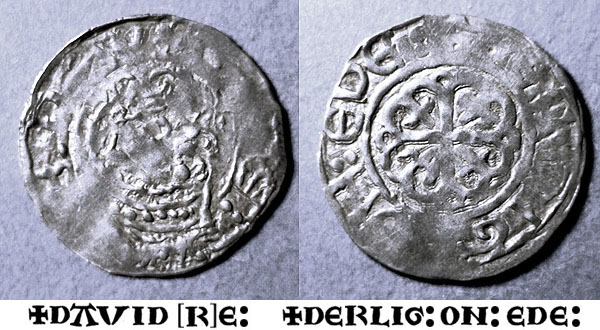
|
Following the Battle of the Standard in 1138, the peace treaty at Durham in 1139 gave Prince Henry, son of David I of Scotland, the earldom of Northumberland. Several mints struck coins for Prince Henry, and at Bamburgh, coins were first struck in the name of Stephen, and then in the name of the prince. This cut half penny in the name of Stephen is extremely rare.
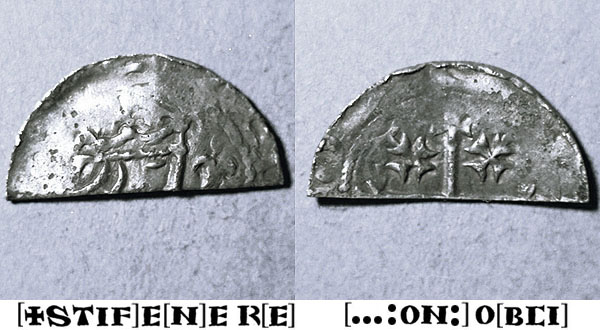
|
Angevin Coinage
Empress Matilda
Prior to her victory of the Battle at Lincoln in February, 1141, coins of the Empress Matilda were of the same cross moline style as that of Stephen's Watford type, but with a legend bearing her title. After her victory in Lincoln, a new coinage was struck with variations of a cross plumee over a saltire fleury. The example shown here is most likely lot #33 from the Coed-Y-Wenallt hoard. It was struck by Elwine in Cardiff.
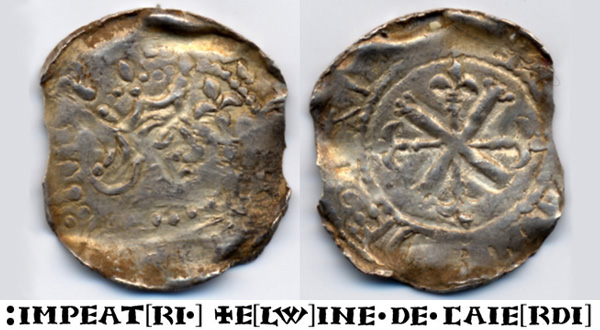
|
mint: Cardiff Very Rare |
Upon Matilda's arrival at Bristol in 1139, pennies were struck in her name, and beginning in 1142, in the name of her son, Henry of Anjou, who would later become Henry II of England. This irregular penny was struck by the moneyer Jordan (IORDAN), and features a bust right with sceptre and a cross in front of the sceptre.
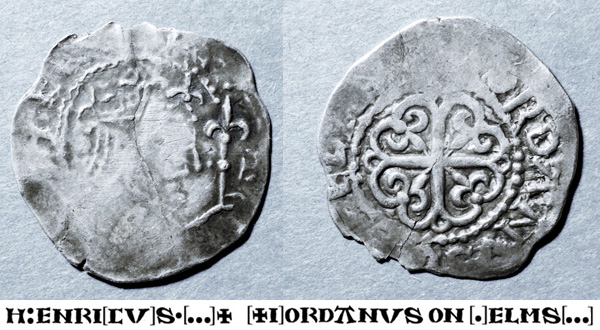
|